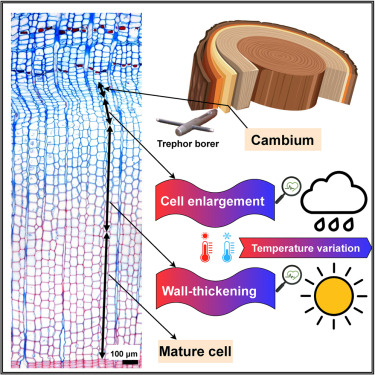Study Unveils Impact of Temperature Variability on Tree Growth Phenology
Given warming-induced decoupling between growth timing and annual woody growth, the subtle responses of wood formation (e.g., xylem phenology) to multiple facets of global warming should be quantified to improve our understanding of forest growth dynamics; however, this task remains challenging. One of the largest uncertainties in the responses of wood formation to global warming is the inferences derived solely from mean annual temperatures.Given the immediate threats posed by worldwide increases in climate variability, there is an urgent need to understand how temperature variability affects the timing of forest wood phenology and the underlying mechanisms.
To bear on this problem, Professor HUANG Jianguo and his team from the College of Life Sciences at Zhejiang University, collaborated with 44 researchers worldwide to bring a new source of high-temporal-resolution wood phenology data encompassing 20 conifer species from 75 study sites across the Northern Hemisphere (23-66°N). They provide the first empirical evidence that increasing temperature variability drive trees to rely on consistent seasonal cues that could provide favorable conditions to initiate the xylem phenological activities, and hence, also contributes to an increase in the spatial synchrony of spring phenology:
Their results indicate that large temperature variability drives the xylem cell wall thickening happens around the Summer solstice, during which the Northern Hemisphere receives the most hours of daylight, which is the optimal time to maximize carbon assimilation and thus, is favorable for cell wall thickening. Their results also indicate that the onset timing of xylem cell enlargement tends to occur on the 5th of June under large temperature variability. Interestingly, rainfall increased since the 5th of June over Northern Hemisphere and sufficient water availability is necessary to support xylem cell division and expansion, and thus, the 5th of June act as a favorable seasonal cue for trees to initiate cell enlargement.

The findings raise intriguing questions, that is, will trees from regions with high temperature variability respond to warming by advancing their spring phenology, or will they initiate xylem cell enlargement and wall thickening on the fixed dates of June 5th and the summer solstice, respectively? Should the latter scenario prevail, areas with large temperature fluctuations may witness a less pronounced response from forests to climate warming than anticipated. Moreover, phenological convergence may intensify competition among trees for vital resources such as water and nutrients, thereby affecting forest structure and productivity. By addressing the gap in woody phenology research on a large scale, this study set a path for future research on the combined effects of global warming and frequent extreme weather events on tree phenology changes as well as the potential structural and functional changes in forests.

